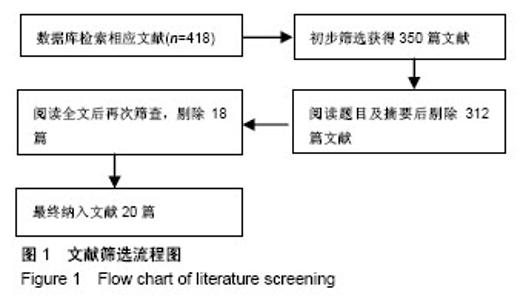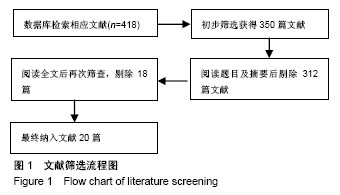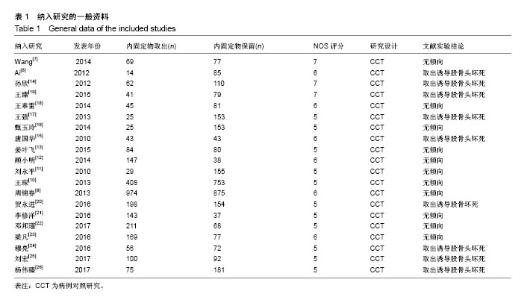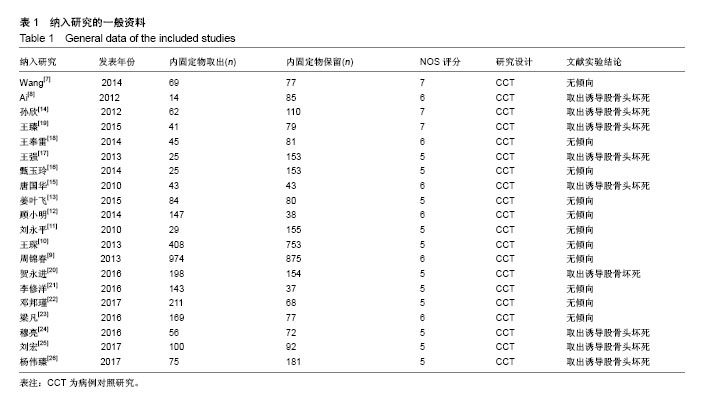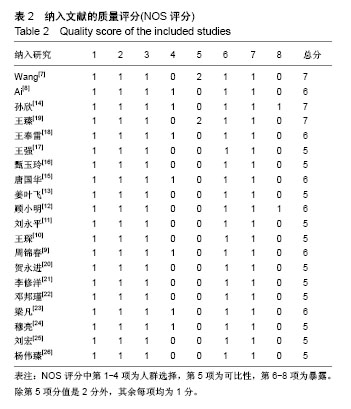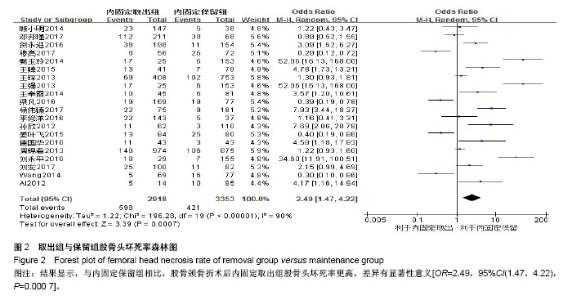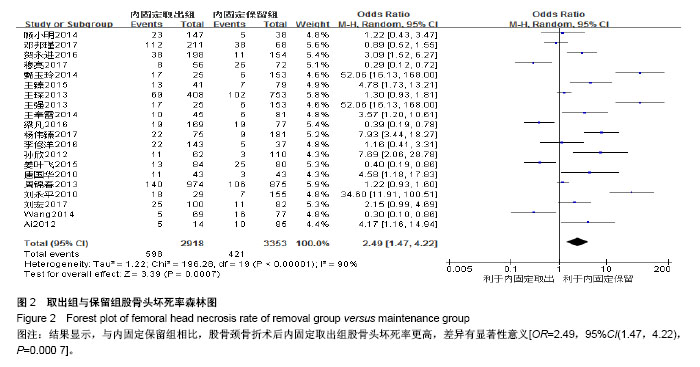| [1] Xia WB, He SL, Xu L, et al. Rapidly increasing rates of hip fracture in Beijing. J Bone Miner Res. 2012;27(1):125-129. [2] 梁凡,彭昊,胡巍,等.股骨颈骨折术后继发股骨头坏死的危险因素分析[J].中华创伤杂志,2016,32(9):813-817.[3] Gao YS, Ai ZS, Zhu ZH, et al. Injury-to-surgery interval does not affect postfracture osteonecrosis of the femoral head in young adults: a systematic review. Eur J Orthop Surg Traumatol. 2013;23(2):203-209. [4] 王海瑞,贺赟,张连生,等.钉道打压植入红骨髓混合异体骨预防中青年经股骨颈内固定拆除后股骨头坏死的近期疗效观察[J].疾病监测与控制杂志,2017,11(2):145-146.[5] 徐世侠,汤先华,陈海青.Meta分析及Revman软件介绍[J].中华医学图书情报杂志,2009,18(3):61-63.[6] 刘鸣.系统评价、meta分析设计与实施办法[M].北京:人民卫生出版社,2010:72-73.[7] Wang T, Sun JY, Zha GC, et al. Analysis of risk factors for femoral head necrosis after internal fixation in femoral neck fractures. Orthopedics. 2014;37(12):e1117-e1123. [8] Ai ZS, Gao YS, Sun Y, et al. Logistic regression analysis of factors associated with avascular necrosis of the femoral head following femoral neck fractures in middle-aged and elderly patients. J Orthop Sci. 2013;18(2):271-276. [9] 周锦春,郭敦明,王青,等. 股骨颈骨折闭合复位加压螺纹钉内固定术后股骨头坏死多中心多因素相关分析[J]. 中华骨科杂志, 2013,33(55):549-554.[10] 王琛,陈宏亮,郭开今. 股骨颈骨折闭合复位内固定术后股骨头坏死率及影响因素的大样本量调查分析[J]. 徐州医学院学报, 2013,33(7):543-546.[11] 刘永平,曾海滨. 股骨颈骨折空心钉内固定后股骨头缺血坏死的影响因素分析[J]. 实用预防医学,2010,17(4):732-733.[12] 顾小明,黄立新. 股骨颈骨折空心加压螺钉内固定后股骨头坏死分析[J]. 实用骨科杂志,2014,20(10):900-905. [13] 姜叶飞,徐阿炳,马玉海,等. 股骨颈骨折术后发生股骨头坏死的影响因素分析[J]. 中国乡村医药,2015,22(24):13-14.[14] 孙欣,曾荣,胡资兵,等. 空心螺钉内固定治疗股骨颈骨折术后股骨头坏死的影响因素分析[J]. 中华创伤骨科杂志,2012,14(6): 477-479.[15] 唐国华. 股骨颈骨折术后内固定物去留对股骨头血运影响观察[J]. 临床研究,2010,17(2):45-46.[16] 甄玉玲.空心钉内固定后发生股骨头坏死的危险因素分析[J].实用诊疗,2014,4(6):37-38.[17] 王强.空心钉内固定治疗股骨颈骨折术后发生股骨头坏死的危险因素分析[J].临床和实验医学杂志,2013,12(22):1845-1847.[18] 王奉雷. 空心钉锁定板治疗股骨颈骨折术后股骨头坏死的危险因素分析[J]. 重庆医学,2014,43(8):909-912. [19] 王臻.空心加压螺钉治疗成人股骨颈骨折术后股骨头坏死高危因素分析[J].实用临床医药杂志,2015,19(15):72-74. [20] 贺永进,李长红,刘志斌. 成人股骨颈骨折术后股骨头坏死高危因素分析[J]. 局解手术学杂志,2016,25(8):612-615. [21] 李修洋,魏刚. 股骨颈骨折空心加压螺钉内固定后股骨头坏死的相关因素[J]. 局解手术学杂志,2016,25(12):898-901. [22] 邓邦瑾,张卫红,文政,等. 股骨颈骨折空心加压螺钉内固定术后股骨头缺血性坏死危险因素分析[J]. 新乡医学院学报, 2017, 34(6):526-528.[23] 梁凡,彭昊,胡巍,等. 股骨颈骨折术后继发股骨头坏死的危险因素分析[J]. 中华创伤杂志,2016,32(9):813-817.[24] 穆亮,安占天,郝岩,等. 空心螺钉内固定治疗股骨颈骨折术后股骨头坏死的影响因素探讨[J]. 临床医药文献杂志, 2017,4(12): 2217.[25] 刘宏,代立武,汤睿,等. 老年股骨颈骨折患者内固定术后发生股骨头坏死的危险因素[J]. 中国临床保健杂志, 2017,20(3): 261-263.[26] 杨伟臻,张剑锋,李文琴,等. 青壮年股骨颈骨折术后股骨头坏死的多元相关性分析[J]. 中国当代医药,2017,24(1):71-75.[27] 王华民. 股骨颈骨折术后内固定物去留对股骨头血液循环影响的临床观察和动物实验研究[D]. 广州:第一军医大学,2004.[28] 姚双权. 间断抜钉对股骨颈骨折愈合影响的研究[D]. 石家庄:河北医科大学,2003.[29] 罗健. 间断拔针对大白兔股骨颈骨折愈合影响的实验研究[D].乌鲁木齐:新疆医科大学,2012.[30] Zielinski SM, Heetveld MJ, Bhandari M, et al. Implant removal after internal fixation of a femoral neck fracture: effects on physical functioning. J Orthop Trauma. 2015;29(9):e285-292. [31] Hanson B, van der Werken C, Stengel D. Surgeons' beliefs and perceptions about removal of orthopaedic implants. BMC Musculoskelet Disord. 2008;9:73. [32] Lovald S, Mercer D, Hanson J, et al. Hardware removal after fracture fixation procedures in the femur. J Trauma Acute Care Surg. 2012;72(1):282-287. [33] Scott Y, Halim BC, Werner F, et al. Does osteonecrosis of the femoral head increase surgical and medical complication rates after total hip arthroplasty? A comprehensive analysis in the United States. Hip Int. 2015;25(3):237-244. [34] 章年年,叶招明,朱仰义,等. 双螺钉系统与3枚空心加压螺钉治疗股骨颈骨折的比较研究[J]. 中国骨伤,2013,26(7):565-571.[35] 汪松,张弢,马信龙,等. 生物力学因素在股骨头坏死发生发展中的作用研究进展[J]. 山东医药,2015,55(11):89-91.[36] 刘建宁,邓仁椿,张汉华,等. 带血管蒂髂骨瓣移位加股骨头髓腔减压术治疗青壮年股骨颈骨折[J]. 中国矫形外科杂志, 2009, 11(22): 1529-1530.[37] Herring JA, Birch JG, Cummings DR, et al.Tachdjian's Pediatric Orthopaedics.Philadephia: WB Saunders Co, 2002: 111-115.[38] Davison BL. Refracture following plate removal insupracondylar-intercondylar femur fractures. Orthopedics. 2003;26(2):157-159. [39] Minkowitz RB, Bhadsavle S, Walsh M, et al. Removal of painful orthopaedic implants After fracture union. J Bone Joint Surg Am. 2007;89(9):1906-1912. [40] Eberle S, Wutte C, Bauer C, et al. Should extramedullary fixations for hip ractures be removed after bone union? Clin Biomech (Bristol, Avon). 2011;26(4):410-414. |
